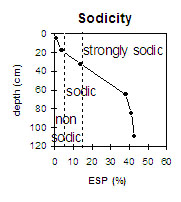MP19
| Location: Hopevale | Australian Soil Classification: Endohypersodic, Pedal, Hypercalcic CALCAROSOL |
| General Landscape Description: Flat on a gently undulating plain | |
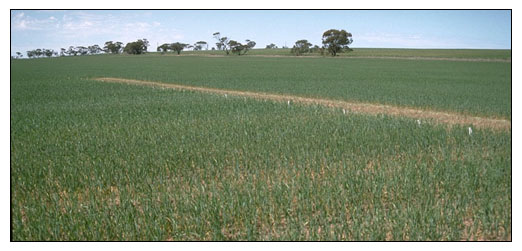 MP19 Landscape |
Soil Profile Morphology:
Surface Soil
| A1 (Ap) | 0-10 cm | Brown (10YR4/3); clay loam; soft surface condition with a few carbonate rocks (2-10%); weak subangular blocky structure; very firm consistence dry; contains very few (<2%) hard carbonate gravels (4 mm in size); highly calcareous; pH 8.5: | 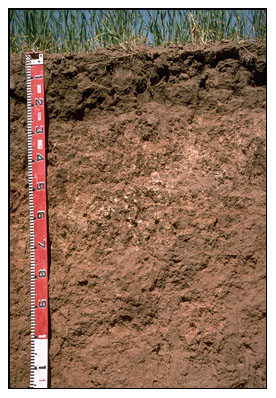 MP19 Profile |
| Subsoil | |||
| B21 | 10-25 cm | Dark yellowish brown (10YR4/4); light clay; weak coarse blocky structure; strong consistence dry; contains very few (<2%) soft carbonates; highly calcareous; pH 8.7: | |
| B22k | 25-60 cm | Reddish yellow (7.5YR6/6); medium clay; moderate coarse prismatic structure; strong consistence dry; contains many (50%) soft carbonates; very highly calcareous; pH 9.4: | |
| B23 | 60-70 cm | Reddish yellow (7.5YR6/6); medium clay; moderate coarse prismatic structure; strong consistence dry; contains very few (<2%) soft carbonates and ferromanganiferous material; also contains earthworm casts; very highly calcareous; pH 9.7: | |
| B24 | 70-100 cm | Reddish yellow (5YR6/6); heavy clay; weak coarse prismatic, parting to strong coarse angular blocky structure; smooth faced peds; very firm consistence moist; contains ferromanganiferous material; highly calcareous; pH 9.6: | |
| B25 | 100+ cm | Light reddish brown (5YR6/4); heavy clay; strong fine angular blocky structure; very strong consistence moist; contains ferromanganiferous material; highly calcareous; pH 8.7. | |
Key Profile Features:
|
Soil Profile Characteristics:
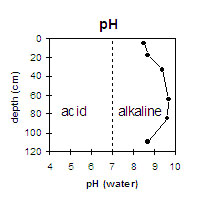 | 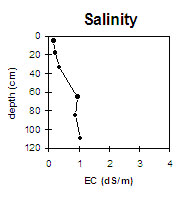 |
| The surface soil is moderately alkaline. The subsoil is strongly alkaline becoming extremely alkaline at 60 cm. | The salinity rating for the surface and upper subsoil is low. At 60 cm the rating becomes high. |
| |
| The surface and subsoil is non-sodic. The profile becomes strongly sodic at 35 cm. |
Management Considerations:
Whole Profile
- The high calcium levels in this profile (down to 60 cm depth) will aid the already high inherent fertility of this soil and help to increase soil aggregation.
- The surface soil is non-sodic, however the soil disperses slightly after remoulding. This is likely to restrict root and water movement somewhat. Gypsum application is likely to help this problem, by replacing the sodium ion on the clay particles with calcium and thus decreasing dispersion.
- The moderately alkaline conditions are tolerable for most plants, where barley and wheat are most tolerant.
- The strongly alkaline profile suggest that some nutrients (e.g. manganese, zinc, iron, copper) may be poorly available to plants.
- The upper subsoil in non-sodic but disperses slightly after remoulding which will restrict root movement. The deeper subsoil becomes strongly sodic at 35 cm depth with a low calcium and magnesium ratio (0.9) as well as complete dispersion. This will restrict root and water movement at depth. Deep ripping and gypsum application may help alleviate this problem. Interestingly, earthworm casts were found at 80 cm depth.
- The salinity rating becomes high at about 60 cm. These levels of soluble salts are likely to restrict the growth of salt sensitive plant species (e.g. faba beans, linseed, chickpeas and lupins).
- The deeper subsoil (>60 cm) has a high level of exchangeable sodium and which may result in nutrient imbalances and may also have a toxic effect on some plants.
Comments:
- At time of sampling MRS were trialing wheat and barley varieties.
- The landholder manages this soil with a grain/pasture/pasture (fallow) rotation. The area is ripped every pasture (fallow) year and Double Super, MAP and PIVOT-Mallee Mix 4 are added to the soil alternately.

